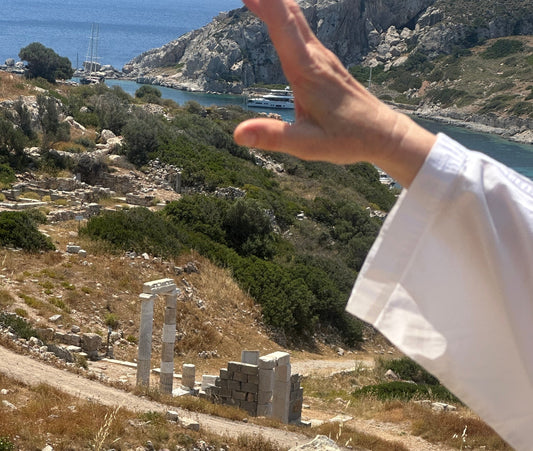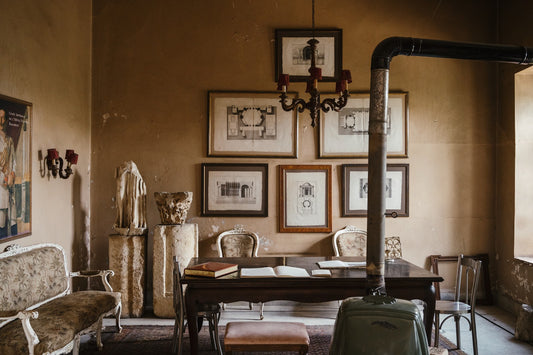Giada Mariani in Yazd, Iran.
A road trip along Iran’s ancient Silk Road is on most Eastern connoisseurs’ wish lists. Cities with names like Shiraz, Isfahan, Pasargade, the mountain peaks of Damavand, the Caspian Sea — recall the verses of Rumi, or the romantic itinerary of a 19th century explorer.
For Giada Mariani, an Italian creative director and photographer, a trip to Iran was destined - when she met her partner in 2018 she was already planning her voyage. “Let’s go together,” he said, recalls Giada. “I chickened out because I knew that couples had to be married (or at least pretend to be) to travel around Iran." Three years later the couple decided to embark, in September of 2022. Traveling by car from the capital in Tehran to Shiraz and on to Persepolis in the south, Giada shares her favorite moments and snapshots with LEVANT.
Setting the Itinerary
GM: We started off in Tehran, where we stayed with a very fascinating and eccentric character named Ramin. My relationship with Ramin started before the trip, back in Florence, where he sent me on errands to incredible places to retrieve some items he had left behind on his latest travels in Italy. Ramin’s house in Tehran is a living cabinet of curiosities, filled with art, books, antiques and objects from his travels. He connected us to some of his friends, and through a network of connections we traveled around the country: First to Kashan, then Isfahan, followed by Yazd, (with a stopover in Maybod) and ending in Shiraz.
Ramin's home is a cabinet of curiosities; antiques, textiles, and special objects from his travels.
Kashan, City of Ceramics
Kashan was a significant trading hub in Medieval Persia, also producing a style of lustreware pottery called Kashan-ware that is specific to the city; white glazed ceramics adorned with birds and florets in rust and blue hues. It houses one of LEVANT’s favorite Iranian bazaars, where you can find unusual antiques — or haggle with a famous rose-bud dealer.
The iconic zig-zag tile of the Kashan Bazaar.
Spices and dried herbs in the bazaar.
A rosewater vendor, a speciality of Kashan.
A dye shop with wools and silk threads in vibrant colors.
GM: We met Hooshmand, the man who drove us from Kashan to Isfahan, while queuing to change money. We exchanged advice (he spoke English which is quite rare), and he offered to drive us as he wanted to go visit his grandmother. That drive was one of the highlights of our trip. He shared so much about his life with us, and it was interesting to learn about Iran through the eyes of this young man.
Isfahan, The Jewel
Naqsh-e Jahan Sqaure in Isfahan.
The city of Isfahan is considered one of Iran’s crown jewels for its sophisticated architecture and its seat as the capital during the illustrious Safavid period. The Naqsh-e Jahan Square boasts some of the most unique mosques and palaces in the country, with the northern gate opening into Isfahan’s Grand Bazaar. Here you’ll find the usual bazaar treats – rows of colorful ‘lavashak’ (sour fruit candies), nuts, spices – but also an elegant array of antique stores and art dealers. This is where serious people come to shop.
Seth Yessyan Hotel in Isfahan.
A coffee house on Isfahan’s square.
GM: In Isfahan we stayed in the Armenian neighborhood, which is vibrant and rich in history. We stayed at a family b&b, the Seth Yessyan Hotel, and we communicated with the host through his daughter, who spoke a little bit of English. On the last night they invited us to the courtyard, and we spent the evening with the family. I remember how fun it was, trying to speak with the children through hand signs. The 8 year old son was particularly fond of Guido.
Yazd, City of Silk
Yazd’s clay and turquoise tiled cityscape.
Yazd was one of the most important cities on the ancient trade route; it was commonly used as a stop-over by Chinese merchants en route to India, and known for its magnificent silks. The city is still a center for artisanal silk production. Giada remembers Yazd’s unique clay structures “the city of mud and wind towers” – one of her favorite destinations on her journey. A skyline of clay structures and turquoise domes is particularly Yazdi.
A dome structure that once stored ice from winter to summer in Meybod, Iran.
An epic 'wind tower' in Yazd, Iran.
Bakers tossing barbari bread.
GM: Yazd impressed me - the architecture and the youthful energy. Everyday we went out on the rooftop terraces of Yazd to watch the sunset and listen to the call to prayer, while drinking chia rose drink and playing backgammon. I found in Yazd that if you look beyond the tourist offerings, you can encounter young and creative realities.
Shiraz, City of Roses
An old Persian expression says if Isfahan is for the head, Shiraz is for the heart. Called the city of roses for its famous bulbs, it was home to the great Persian romantic poets Sa’di and Hafez, as well as the historic site of Persepolis. Shirazis are known for their soulful demeanor, and the splendor of their gardens.
“Judge with thine eyes, and set thy foot in the garden fair and free, and tread the jasmine under thy foot, and the flowers of the Judas-tree. Oh joyous and gay is the New Year's Day, and in Shiraz most of all; Even the stranger forgets his home, and becomes its willing thrall.” - Sa'di, on Persian Spring New Years in Shiraz
A mantelpiece at the Ravi Boutique Hotel mimics the reliefs at nearby Persepolis.
The Ravi Boutique Hotel in Shiraz.
Throughout her travels, Giada stayed at converted caravanserais. In Shiraz, the Ravi Boutique Hotel particularly stood out.
GM: In Shiraz, we bought carpets and visited the botanical gardens, and the Pink Mosque which was pretty wow. The Pink Mosque of Shiraz has beautiful pink tiles and rose-tinted glass windows that reflect light throughout the prayer rooms.
Persepolis
Just outside of Shiraz lies Persepolis, the ancient city founded by Darius the Great, King of the Achaemenid Empire. The site is on a remote desert compound; the temples and columns, mythical griffin and lion busts greet dusty visitors. Persepolis was built in 518 BC when Persia was Zorastrian. It was seized by Alexander the Great’s army in 330 BC, and while the city was burned to the ground, many archaeological remnants remain intact, including the famous Apadana reliefs.
At Persepolis, Giada met a nomad woman from the Khamseh tribe, photographed here in front of the Apadana reliefs.
Giada and Guido finished their trip in Persepolis, a fitting end to a mythic voyage – they met a nomad woman from the Khamseh tribe, known for their brightly colored sequin dresses and tulle skirts.
Giada and her partner, Guido.
Giada’s Favorite Discoveries:
The people and their kindness.
There are still places in the world where you have to use google translate with the voice feature to communicate.
Rose water with Chia seeds.
Iranian breakfast! Sangak bread with white cheese, cucumbers, honey, butter, and jam, pomegranate juice, and sweet caramelized carrots.
Gole Yakh song by Kourosh Yaghmaei.
All the caravanserai and the spice markets.
Tehran to Shiraz Roadtrip Playlist:
Iranians are known for their romantic and dramatic spirits. Get in the mood with soulful Iranian ballads from the 1970s, as well as Turkish and Lebanese artists of the 60s and 70s.






















